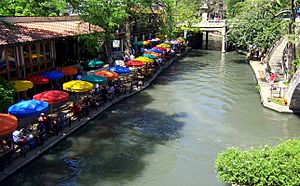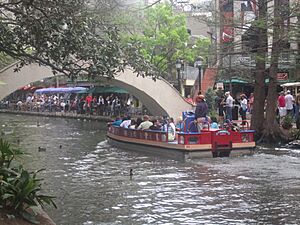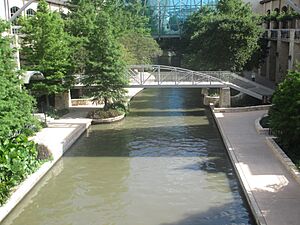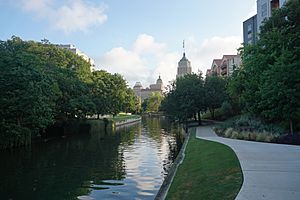San Antonio River Walk facts for kids
The San Antonio River Walk is a famous path system in San Antonio, Texas. It's like a special street just for people, located one level below the busy car streets. The River Walk winds and loops under many bridges. It has two sidewalks along the river, filled with restaurants and shops. This beautiful pathway connects many popular places. You can reach the Shops at Rivercenter, the Arneson River Theatre, Marriage Island, La Villita, HemisFair Park, the Tower Life Building, the San Antonio Museum of Art, and the Pearl. It also links to the city's five Spanish colonial missions, including the Alamo, which are a World Heritage Site. Every spring during Fiesta San Antonio, a special River Parade takes place with colorful, flowery floats floating down the river.
Contents
History of the River Walk
In September 1921, a terrible flood hit the San Antonio River. This flood caused 51 deaths, and 23 more people went missing. After this disaster, city leaders started making plans to control the river's floods. One idea was to build a dam upstream, called the Olmos Dam. Another plan was to create a bypass channel around a big bend in the river downtown. Some even suggested paving over this bend to make a storm sewer.
Work on the Olmos Dam and the bypass channel began in 1926. However, the San Antonio Conservation Society strongly disagreed with paving over the river bend. They successfully stopped that part of the plan. No big new plans came forward until 1929. That year, Robert Hugman, an architect from San Antonio, shared his ideas. His plans would eventually become the River Walk we know today. Many people helped develop the site, but former mayor Jack White was key. He helped pass a bond issue in 1938. This raised money for the "San Antonio River Beautification Project," which started turning the area into the 2.5-mile-long (4 km) River Walk.
Hugman's Vision for the River
Hugman liked the idea of the bypass channel, which was finished later that year. But instead of paving the river bend, he suggested something different. He wanted a flood gate at the north end of the bend and a small dam at the south end. He also planned a special gate in the channel to control the water flow. Hugman imagined the bend surrounded by shops and businesses, calling it "The Shops of Aragon and Romula." He even set up his own architect's office right on the bend.
At first, many people didn't like Hugman's plan. The area was known for being unsafe. At one point, military members were even told to stay away. People worried they could be "drowned like a rat" if the river flooded. But over the next ten years, more and more people supported developing the river bend. Important funding came in 1939 from the Works Progress Administration (WPA). This led to the first construction of about 17,000 feet (5,182 meters) of walkways. Workers also built about twenty bridges and planted many trees, including some bald cypress trees. Some of these trees are hundreds of years old, and their branches reach up to ten stories high, visible from the street.
Hugman's hard work paid off, and he became the project architect. His plan was tested in 1946 when another big flood threatened downtown San Antonio. But the Olmos Dam and bypass channel worked well, greatly reducing the damage. In 1946, Casa Rio, a famous River Walk restaurant, opened next door to Hugman's office. It was the first restaurant in the area.
Expanding the River Walk
Over the years, the River Walk has been improved and made longer. The first major extension happened for HemisFair '68, a big world's fair. This expansion stretched the River Walk beyond its original banks to the new convention center and theater. This was also when the Hilton Palacio del Rio hotel was built. It was the first of many downtown hotels to have a spot along the river. Another big expansion opened in 1988. It created a lagoon at the new Rivercenter Mall and the Marriott Rivercenter Hotel.
In 1981, the Hyatt Regency San Antonio hotel opened. It added a new path called the Paseo del Alamo. This path connected Alamo Plaza to the River Walk with waterfalls and plants. This "extension" actually flows from Alamo Plaza through the hotel's lobby into the San Antonio River. This connection lets the hotel say it's on both Alamo Plaza and the River Walk. It also gives the city a park that links its two biggest tourist spots.
Many buildings downtown, like the Casino Club Building, have two entrances. One is at street level, and another is one level below, facing the river. This helps separate cars and delivery vehicles from people walking below. It uses a complex system of bridges, walkways, and old staircases. The San Antonio Spurs basketball team has even held their NBA Championship victory parades on boats along the River Walk!
Growth and New Sections
There are plans to make the River Walk even longer, reaching areas north and south of downtown. As more chain restaurants have opened, some people at City Hall have talked about limiting them. They want to keep the River Walk feeling unique and local. On May 30, 2009, the city opened the $72 million Museum Reach section. This part of the River Walk connects to places like the San Antonio Museum of Art and The Pearl Brewery. The Pearl has become a very popular spot for local people.
Two years later, in May 2011, the River Walk grew by several miles. This new section, called the "Mission Reach," goes from downtown all the way to Mission Espada on the city's south side. The Mission Reach is special because it focuses on helping nature and improving trails for hiking and biking. It has paddling trails and biking trails. These allow visitors to explore the UNESCO World Heritage Missions.
For years, locals and tourists have wondered about the water's quality. There has been talk about cleaning it up, even though the muddy bottom makes it hard. The muddy bottom does get a special cleaning every year during the Mud Festival.
In early 2016, the River Walk connected with another urban pathway for the first time. This was the San Pedro Creek Greenway. This greenway joins the River Walk where San Pedro Creek meets the San Antonio River, near Mission Concepción.
On May 25, 2017, Esperanza Andrade and Lisa Wong won a big contract. Their company, Go Rio San Antonio, will operate the river barges. The San Antonio City Council voted 10-1 in their favor for the $100 million contract. When she received the contract, Andrade told the council, "We not only know but we understand why the River Walk is indeed our crown jewel of our beautiful city. And we understand that the barge operation is the thread that weaves it all together."
River Walk's Impact
The San Antonio River Walk has been so successful that it has inspired similar projects in other cities. Some examples include the Little Sugar Creek Greenway in Charlotte, North Carolina, the Cherry Creek Greenway in Denver, Colorado, The Bricktown Canal in Oklahoma City, Oklahoma, and the Santa Lucía Riverwalk in Monterrey, Mexico.







